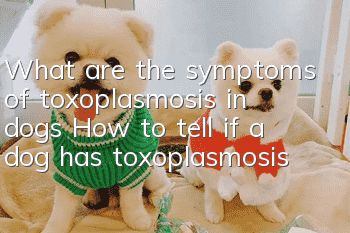What are the symptoms of toxoplasmosis in dogs? How to tell if a dog has toxoplasmosis?

Many people like to keep pets, but there are still confusions or misunderstandings about the characteristics of dogs and the spread of diseases. Certain diseases between dogs and humans can indeed be transmitted to each other, but certain transmission conditions are required. In daily life, only feed dog food, do not give raw food or some contaminated food, inject vaccinations as required, do regular physical examinations, plus daily personal hygiene (wash your hands after contact with animals, especially feces), to achieve these, human and human health Disease transmission between dogs is extremely unlikely. So what are the symptoms of toxoplasmosis in dogs? How to tell if a dog has Toxoplasma gondii? Next, let’s follow the editor to find out.
How to tell if a dog has Toxoplasma gondii?
Toxoplasmosis in dogs is divided into acute and chronic types. When a dog is infected with Toxoplasma gondii , symptoms such as listlessness, lethargy, vomiting, diarrhea, loss of appetite, coke deficiency, elevated body temperature, increased eye feces, red eye sockets, difficulty breathing, weight loss, and anemia will occur.
1. Listlessness
Dogs usually do not have very obvious symptoms after being infected with Toxoplasma gondii. However, there are also some dogs with weak constitutions or sensitive constitutions that will show symptoms such as listlessness, lethargy, and anxiety for a period of time after being infected with Toxoplasma gondii.
2. Vomiting and diarrhea
In the early stages of Toxoplasma infection, dogs may experience symptoms such as vomiting, soft stools, and diarrhea, but the reactions are relatively mild, and The dog may improve quickly in a short period of time, so the owner may not notice it. Once the dog develops these conditions, it is best for the owner to take the dog to the doctor for a fecal examination to achieve early detection and early treatment.
3. Loss of appetite
When dogs are infected with toxoplasmosis, they will also have symptoms such as loss of appetite, even anorexia, hunger strike, etc., and sometimes Obsessive-compulsive disorder, anxiety disorder, phobia and other neurological symptoms. When a dog has abnormal mental state and appetite at the same time, accompanied by vomiting or diarrhea, the owner may suspect that the dog has Toxoplasma gondii.
4. Increased body temperature
Toxoplasmosis can be divided into acute and chronic. Dogs with acute Toxoplasma infection will be accompanied by an increase in body temperature to Symptoms such as temperatures above 40 degrees, a large increase in eye feces, red eye sockets, and difficulty breathing. Dogs with chronic Toxoplasma infection will show symptoms such as body weight loss and anemia.
- Can dogs eat cabbage?
- Why does a puppy sneeze?
- What does it mean when a dog is always grunting?
- Can dogs still be trained when they are older? The best time to train dogs!
- Why does the dog poop white?
- How to tell if a Labrador has canine distemper?
- Prevention and treatment of canine parvovirus disease
- How to deworm puppies?
- How do novices train a Rottweiler to be docile? Rottweiler training tips!
- How to educate a golden retriever when it eats randomly? A must-read for novice dog trainers!



